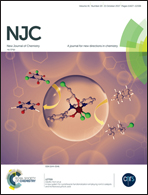γ radiation-induced damage of nucleic acid bases, calf thymus DNA and DNA within MCF-7 breast cancer cells by [Cu2(OAc)4(tnz)2]: a potential radiosensitizer†
Abstract
A dimeric complex of Cu(II) with tinidazole characterized earlier was used to study radiosensitizing attributes. Studies reveal that the complex is better than tinidazole in sensitizing radiation-induced damage of nucleic acid bases uracil and thymine, radiation-induced double strand modification of calf thymus DNA and modification of DNA within MCF-7 breast cancer cells. The unique aspect of this study is that in spite of a substantial decrease in the generation of the nitro-radical anion (NO2˙−) following complex formation of tinidazole with Cu(II), no decrease was observed in the radiosensitizing attribute of nitroimidazoles. Rather the complex was clearly ahead of tinidazole with regard to radiosensitization. Hence, complex formation of important drug molecules are an advantage since it helps to target DNA better. This study serves as a good example where a common intermediate (NO2˙−) responsible for efficacy as well as toxic side effects can be suitably tuned in its generation using a modified form of 5-nitroimidazole (here tinidazole) to be able to strike the correct balance between efficacy and toxic side effects.
![Graphical abstract: γ radiation-induced damage of nucleic acid bases, calf thymus DNA and DNA within MCF-7 breast cancer cells by [Cu2(OAc)4(tnz)2]: a potential radiosensitizer](/en/Image/Get?imageInfo.ImageType=GA&imageInfo.ImageIdentifier.ManuscriptID=C7NJ02061A&imageInfo.ImageIdentifier.Year=2017)


 Please wait while we load your content...
Please wait while we load your content...